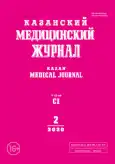Effect of minimally invasive extracorporeal circulation on endothelial dysfunction in cardiac surgery patients
- Authors: Kornev VI1, Kalinina NM1, Startseva ON1
-
Affiliations:
- The Nikiforov Russian Center of Emergency and Radiation Medicine, EMERCOM of Russia
- Issue: Vol 101, No 2 (2020)
- Pages: 279-283
- Section: Clinical experiences
- URL: https://journals.rcsi.science/kazanmedj/article/view/19084
- DOI: https://doi.org/10.17816/KMJ2020-279
- ID: 19084
Cite item
Full Text
Abstract
Aim. To assess the changes in endothelial dysfunction in patients undergoing cardiac surgery with minimally invasive extracorporeal circulation (MiECC).
Methods. The study included 50 patients who were undergoing coronary artery bypass grafting (CABG) surgery with cardiopulmonary bypass (CPB). The patients were divided assigned to either a minimally invasive cardiopulmonary bypass system (group 1, n=15) or standard extracorporeal circuit (group 2, n=35). Changes in the laboratory parameters were assessed 5 times: before the operation, 5 minutes after protamine sulfate administration, 12 hours after the operation, 7 days after the patient's discharged from the hospital and one month after the operation. The activity of von Willebrand factor, factor VIII, and the number of activated platelets were examined in all patients in venous blood.
Results. After protamine sulfate administration, the activity of von Willebrand factor was increased to 164% in the group 1, and up to 193% in the group 2, with a tendency to increase the indicator after 12 hours. The peak of endothelial dysfunction, with the growth of von Willebrand factor and factor VIII, occurs on the 7th day after the operation. In patients of the group with MiECC, von Willebrand factor activity was decreased at the hospital discharge and returned to normal in 1 month. The number of activated platelets increases mainly in group 2 (6% versus 4% in group 1, p=0.29). The expression of P-selectin was significantly higher in group 2 at the hospital discharge (5.5% versus 3.1% in group 1, p <0.001), and in 1 month (4.5% versus 2.3% in group 1, p <0.001).
Conclusion. In patients with minimally invasive cardiopulmonary bypass, platelet activation decreases, endothelial dysfunction, accompanied by an increase in the von Willebrand factor and factor VIII activity, is less pronounced; the seventh day after surgery is a period of the high risk of thrombogenic complications.
Full Text
##article.viewOnOriginalSite##About the authors
V I Kornev
The Nikiforov Russian Center of Emergency and Radiation Medicine, EMERCOM of Russia
Author for correspondence.
Email: v.i.kornev@mail.ru
SPIN-code: 1095-5510
Russian Federation, Saint Petersburg, Russia
N M Kalinina
The Nikiforov Russian Center of Emergency and Radiation Medicine, EMERCOM of Russia
Email: v.i.kornev@mail.ru
SPIN-code: 3399-4781
Russian Federation, Saint Petersburg, Russia
O N Startseva
The Nikiforov Russian Center of Emergency and Radiation Medicine, EMERCOM of Russia
Email: v.i.kornev@mail.ru
Russian Federation, Saint Petersburg, Russia
References
- Hoffman M., Monroe D.M. A cell-based model of hemostasis. Thromb. Haemost. 2001; 85 (6): 958–965. PMID: 11434702.
- Pizov N.A., Pizov A.V., Skachkova O.A., Pizova N.V. Endothelial function in normal and pathological conditions. Meditsinsky Sovet. 2019; (6): 154–159. (In Russ.) doi: 10.21518/2079-701X-2019-6-154-159.
- Elci M.E., Kahraman A., Mutlu E., Ispir C.S. Еffects of minimal extracorporeal circulation on the systemic inflammatory response and the need for transfusion after coronary bypass grafting surgery. Cardiol. Res. Pract. 2019; 2019: 1726150. doi: 10.1155/2019/1726150.
- Ranucci M., Baryshnikova E. Inflammation and coagulation following minimally invasive extracorporeal circulation technologies. J. Thorac. Dis. 2019; 11 (suppl. 10): S1480–S1488. doi: 10.21037/jtd.2019.01.27.
- Wippermann J., Albes J.M., Hartrumpf M. et al. Comparison of minimally invasive closed circuit extracorporeal circulation with conventional cardiopulmonary bypass and with off-pump technique in CABG patients: selected parameters of coagulation and inflammatory system. Eur. J. Cardiothorac. Surg. 2005; 28 (1): 127–132. DOI: 10,1016/j.ejcts.2005.03.032.
- Linden M.D. The hemostatic defect of cardiopulmonary bypass. J. Thromb. Thrombolysis. 2003; 16 (3): 129–147. doi: 10.1023/b:thro.0000024051.12177.e9.
- Perthel M., El-Ayoubi L., Bendisch A. et al. Clinical advantages of using mini-bypass systems in terms of blood product use, postoperative bleeding and air entrainment: an in vivo clinical perspective. Eur. J. Cardiothorac. Surg. 2007; 31 (6): 1070–1075. doi: 10.1016/j.ejcts.2007.01.065.
- Johnell M., Elgue G., Larsson R. et al. Coagulation, fibrinolysis, and cell activation in patients and shed mediastinal blood during coronary artery bypass grafting with a new heparin-coated surface. J. Thorac. Cardiovasc. Surg. 2002; 124 (2): 321–332. doi: 10.1067/mtc.2002.122551.
Supplementary files






